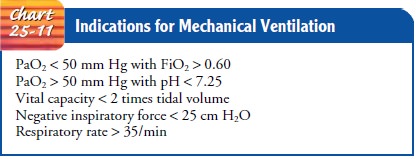Chapter: Medical Surgical Nursing: Respiratory Care Modalities
Mechanical Ventilation
Mechanical Ventilation
Mechanical
ventilation may be required for a variety of reasons, including the need to
control the patient’s respirations during surgery or during treatment of severe
head injury, to oxygenate the blood when the patient’s ventilatory efforts are
inadequate, and to rest the respiratory muscles. Many patients placed on a
ventilator can breathe spontaneously, but the effort needed to do so may be
exhausting.
A
mechanical ventilator is a positive- or negative-pressure breathing device that
can maintain ventilation and oxygen deliv-ery for a prolonged period. Caring
for a patient on mechanical ventilation has become an integral part of nursing
care in critical care or general medical-surgical units, extended care
facilities, and the home. Nurses, physicians, and respiratory therapists must
un-derstand each patient’s specific pulmonary needs and work to-gether to set
realistic goals. Positive patient outcomes depend on an understanding of the
principles of mechanical ventilation and the patient’s care needs as well as
open communication among members of the health care team about the goals of therapy,
weaning plans, and the patient’s tolerance of changes in ventila-tor settings.
INDICATIONS FOR MECHANICAL VENTILATION
If
a patient has a continuous decrease in oxygenation (PaO2),
an increase in arterial carbon dioxide levels (PaCO2),
and a persistent acidosis (decreased pH), mechanical ventilation may be
neces-sary. Conditions such as thoracic or abdominal surgery, drug overdose,
neuromuscular disorders, inhalation injury, COPD, multiple trauma, shock,
multisystem failure, and coma all may lead to respiratory failure and the need
for mechanical ventila-tion. The criteria for mechanical ventilation (Chart
25-11) guide the decision to place a patient on a ventilator. A patient with
apnea that is not readily reversible also is a candidate for me-chanical
ventilation.

Related Topics